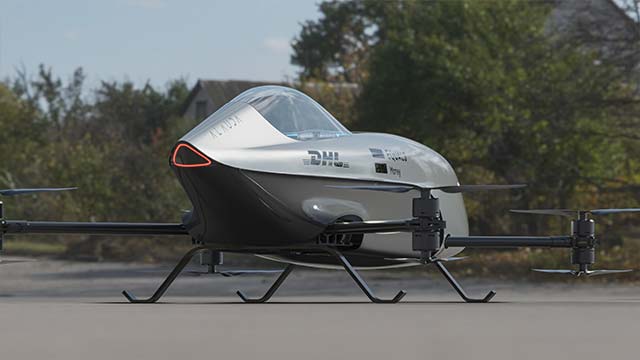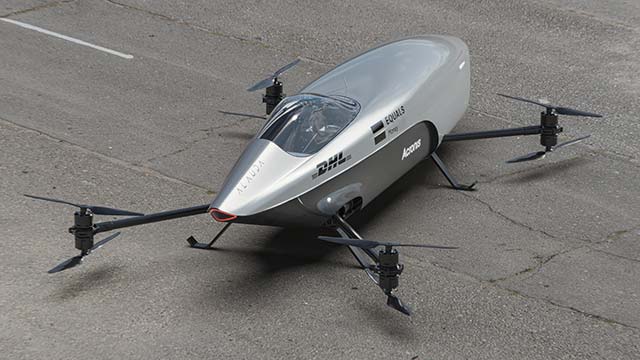
Airspeeder unveiled the world’s first fully functioning electric flying racing car. The Airspeeder Mk3, is a full-sized remotely-operated electric vertical take-off and landing vehicle (eVTOL). It will compete in an upcoming remotely-piloted Airspeeder racing series that will stand as a technical test-bed and feeder series to a manned racing series in 2022. The unveiling of the vehicle represents the realisation of more than three years development work to create a sport that will accelerate a new clean-air aerial mobility revolution.
A full grid of Mk3 electric flying race-craft is currently being manufactured at Airspeeder and Alauda’s technical HQ in Adelaide, South Australia. More than 10 identical racing vehicles will be produced and supplied to teams in 2021. The craft is being developed and manufactured by a team drawn from leading names in aerospace, automotive and motorsport technology including Mclaren, Babcock Aviation, Boeing, Jaguar Land Rover, Rolls-Royce and Brabham.
The Airspeeder Mk3 racing series will be announced in the coming months. These remotely-piloted races will present to the world for the first time close-quarter flying circuit racing at speeds of more than 120km/h.
Airspeeder’s first races will take place in 2021. Final behind-closed-doors pre-season tests will happen in Australia before the start of an international racing calendar. These landmark moments will make history in showing for the first time a full-scale vision of electric flying car racing.
The initial Mk3 races will provide vital information on vehicle dynamics, performance, safety and powertrain technology that will inform the final development of the manned Mk4 Airspeeder vehicle. Racing will play a vital role in hastening the arrival of eVTOL technologies which promise to revolutionise urban passenger mobility, logistics and even remote medical transport. Both the remotely piloted Mk3 programme and manned Airspeeder Mk4 flying cars will provide a safe environment from where key innovations around safety, noise and batteries can be refined and fed into the wider development of an industry predicted by Morgan Stanley to be worth $1.5 trillion by 2050.

THE AIRSPEEDER MK3 | TECHNICAL DETAILS
The Airspeeder Mk3 represents a giant technical leap forward in the development of the world’s first racing series for electric flying cars.
This remotely-piloted vehicle is the final iteration of an electric flying racing car before the introduction of manned racing craft, the Airspeeder Mk4, due to debut in 2022.
Safety systems:
The craft, which will be operated by an expert remote operator from the ground, features a suite of technologies and engineering elements never before seen on an eVTOL craft. These innovations will be validated in this key unmanned proving phase and include LiDAR and Radar collision avoidance systems that create a ‘virtual forcefield’ around the craft to ensure close but ultimately safe racing. The Mk3 features a carbon fibre frame and fuselage chosen for its strength, stiffness and lightweight properties, which ensures maneuverability, performance and efficiency. The carbon fibre frame and fuselage adds a vital mechanical layer of safety, which will be further enhanced by a full carbon fibre monocoque body to be introduced on the Mk4 vehicle.
Powertrain:
The MK3 powertrain represents a significant upgrade on the Mk2 proof of concept vehicle, with power increased by 95% with only a 50% increase in weight. A 96 kW electric powertrain already sees the Mk3 operating with a thrust to weight ratio above two, on a craft that weighs just 100KG unmanned. The Mk3 speeders will fly at speeds in excess of 120 km\h.
Maneuverability and stability:
The Mk3 speeders are laid-out in an ‘octocopter X formation’. This provides significant advantages to pilots in terms of maneuverability and stability. When racing the pilot will be able to make the same sharp hairpin style turns as a Formula 1 car but with the added third dimension of being able to move vertically. The octocopter configuration also adds an important measure of vehicle redundancy and will ensure the craft can safely land and remain in control should a rotor or battery system fail.
Rapid pit stops:
Airspeeder GPs will include rapid pit stops. To facilitate this, Alauda’s engineers have developed an innovative ‘slide and lock’ system for the rapid removal and replacement of batteries when on the ground, this technology debuts on the Mk3. A strategic layer is added to the sport with this approach as teams will be able to adapt battery strategy depending on the dynamic requirements of that particular section of the race. For example, for courses requiring more maneuverability but less straight line speed, a lighter battery pack can be easily selected to deliver more maneuverability at the cost of raw power or endurance.

A year of progress:
2020 was an extraordinary year of progress for Airpseeder and Alauda. The unveiling of the Mk3 craft represents a landmark moment in the development of both the racing series, Airspeeder, and Alauda, the manufacturer that will create the vehicles that race in it. In the Spring of 2020, the company received significant institutional backing from Saltwater Capital and Jelix Ventures.
This accelerated the growth at the firm’s first technical HQ in Adelaide, Australia with senior engineers joining the firm from leading names in performance automotive, aviation and motorsport.
A strategically important technical partnership was then forged with leading cyber-protection firm, Acronis, a significant backer of F1 and professional football. They join global logistics giant, DHL and leading money management firm, Equals, in backing a vision to hasten the dawn of a mobility revolution through sporting competition.
In London, the commercial home of the sport, the team has grown to facilitate the rapid growth of its global fan-base, setting the scene for the development of a permanent engineering base. Finally, presence has been established on a third continent with the recruitment of a Head of Partnerships in New York City.
Airspeeder is built on the philosophy that nothing accelerates technical progress like sporting competition. The next generation sport plays the same role the pioneers of Formula One did nearly a century ago in driving technical development and building public acceptance for a new mobility revolution. The eVTOL sector is primed to transform urban aerial transport, global logistics and even remote medical transport with a clean-air, zero emissions aerial transport solution.
Source: electriccarsreport.com
